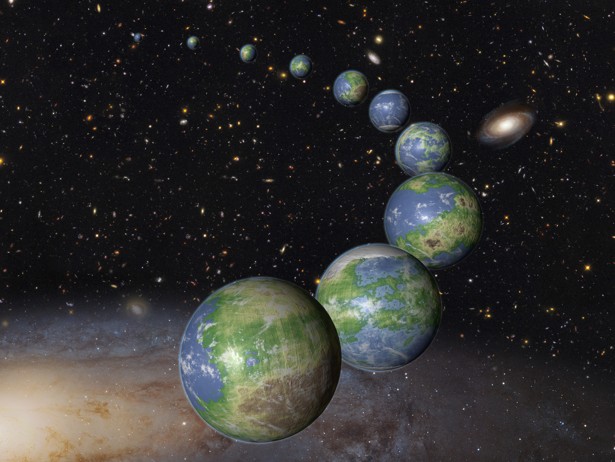
Throughout the universe, trapped in the halos of dark matter, there is enough planet-making material to create at least 1,000,000,000,000,000,000,000 more Earth-like planets. A billion trillion of them. In the Milky Way alone, that would mean another 5 billion Earth-like planets over time.
That’s according to new research by astronomers at the Space Telescope Science Institute in Baltimore, whose findings suggest that Earth, and the life it supports, is only among the first in a massive sprawl of potentially habitable planets that will eventually form in the universe.
“We show that this would imply at least a 92 percent chance that we are not the only civilization the universe will ever have,” wrote Peter Behroozi and Molly Peeples, whose conclusions are drawn from a mix of Hubble and Kepler data.
If they turn out to be right, the universe will end up making more than 10 times the number of planets that are already out here. That means more than 10 times the 1 billion Earth-sized worlds already believed to be in the galaxy, and more than 10 times the planets in the 100 billion other galaxies we know about.
The astronomers focused on the observable universe as a framework for determining how many Earth-like planets might someday exist since there’s no way to calculate what lies beyond it. “This is a bit of a tricky question since the universe is infinite, and so the number planets in it now or in the future is infinite,” Peeples told me. “As we show in the paper, if ours is the first civilization to form, then there is only a 8 percent chance that it will be the only civilization ever. So I would say that's a really good chance that the universe will at some other time and place develop ‘intelligent’ life.”
These calculations are, of course, theoretical. If there is a straightforward relationship between the formation of Earth-like planets and the evolution of intelligent life, scientists on this planet have yet to establish how it works. In other words, just because you have a universe messy with Earth-like planets doesn't mean you're going to wind up with the same or even similar evolutionary processes playing out on each one.
These estimates run contrary to earlier ideas about Earth’s formation, which said our planet emerged only after some 80 percent of similar planets had already formed. “The last star isn’t expected to burn out until 100 trillion years from now,” wrote the Royal Astronomical Society in a statement about the research. “That's plenty of time for literally anything to happen on the planet landscape.”
For those of us who are alive and living on Earth at this moment, these findings represent a new sort of contextualization for humanity’s place in the universe. They suggest we are, or will be, an ancient civilization.
“If you’re aware of the golden records that Carl Sagan had attached to the Voyager missions,” Behroozi said, “it’s amazing to think that it may not be any current civilization that discovers them, but instead one that hasn’t even been born and won’t be born for another trillion years!”
Even in the vacuum of space, the Golden Record isn’t likely to last that long. Given the size and scope of the universe, it’s conceivable that our planet will be forgotten to time, long-since erased into space dust by the time other intelligent life goes looking for traces of our existence.
But there’s still something reassuring, Behroozi says, about the idea that the universe isn’t ours alone for all of time. “It’s indeed somewhat comforting to know that, even if we’re not necessarily the first, we’re almost certainly not the last.”